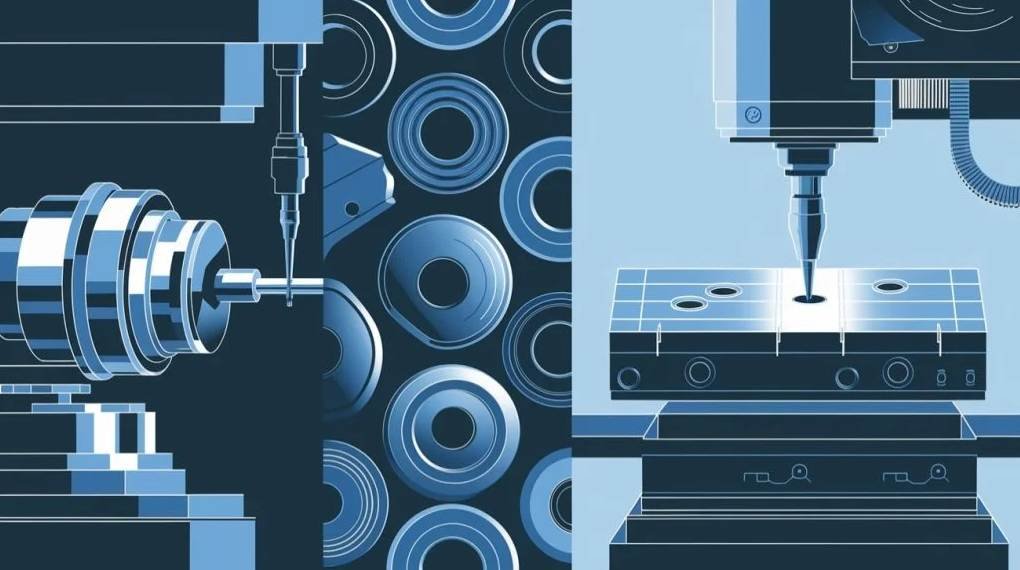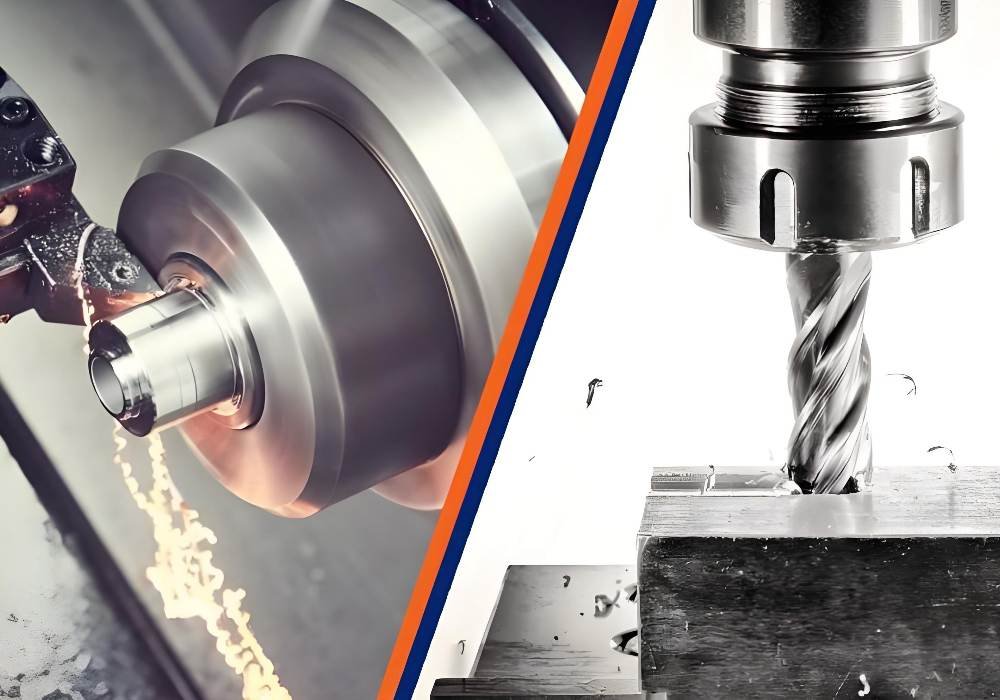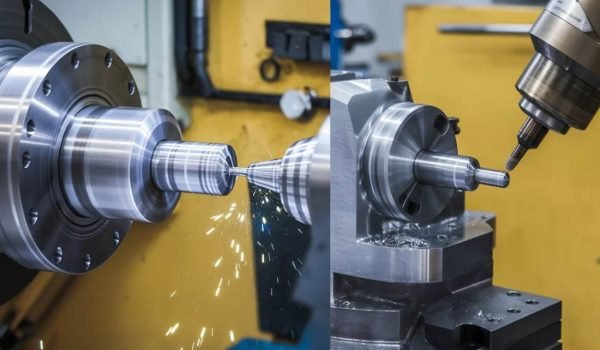In today’s manufacturing industry, CNC machining plays a vital role in producing precise and complex components with high efficiency. Here, an automated production process controls machine tools using computer programming, decreasing the amount of human error and increasing production efficiency.
The two most basic CNC machining operations are CNC turning and CNC milling. It is crucial to learn about their differences in order to choose the appropriate machining process, trade-offs, efficiency, and cost-effectiveness.
This article discusses the main distinction between CNC turning and milling and provides an explanation for their procedure, benefits, and uses in several areas of industry. So, keep reading to know what process is most suitable for a particular manufacturing need.
CNC Turning and CNC Milling Explained
Here is an overall difference in what these CNC machining processes are and how they work.
What is CNC Turning?
CNC turning is a subtractive manufacturing process whereby a workpiece is formed, in cylindrical or conical shape, by the removal of material with a stationary cutting tool from a rotating workpiece. It is one of the most frequently used methods in CNC machining. It is extensively used for the fabrication of precision-made parts including shafts, bushings, bolts, and the like, undergoing rotary movement.
CNC turning is very productive in producing symmetrical parts with fine furnishings and tight registrations. It is widely adopted in manufacturing fields, automotive, aerospace, and medical industries where accuracy and reproducibility are of great importance for performance-critical parts.
What is CNC Milling?
CNC milling is another manufacturing process where the workpiece is stationary (not rotating) while the cutting tool rotates along multiple axes to form the required shape. In this process, the tool can move along several axes and sometimes even as many as six different axes for highly complicated shapes. Given the intricacy of the process, the milling tool comes pre-programmed with instructions to ensure high precision and accuracy.
This process is very apt for non-symmetrical and complex parts, especially custom-designed parts for various industries including aerospace and automotive.

Difference between CNC Turning and CNC Milling Processes
CNC Turning Process
CNC turning process begins with clamping the workpiece into a rotating spindle. The device then proceeds to rotate the workpiece to a predetermined speed while a cutting tool goes all around the workpiece surface and removes chips and mold the workpiece into the required shape. Operators use computerized instructions to control the motion of the cutting tool in order to attain precision and repeatability.
It completely depends on how complex the part to be manufactured is to determine the number of operations that can be carried out during the process, e.g. facing, drilling, threading, grooving, etc. The instrument makes cuts along the external diameter or internally within the workpiece to produce internal features e.g., bore and hole.
With the increasing need in industries such as aerospace, automotive and medical for high accuracy components at a low cost, CNC turning presents an attractive solution. Its ability to produce symmetric parts with minimal material loss enhances efficiency and savings.
CNC Milling Process
In this process too, you begin by securing the workpiece into a stationary table. Unlike in CNC turning, CNC milling involves a stationary workpiece and a moving multi-axis cutting tool which works at a high speed. This lets the tool precisely cut the intricate geometry by removing the material.
The precision and movement of the tool is controlled by computerized instructions ensuring that all repeated actions are highly accurate. The process can include a variety of operations such as contour milling, slotting, drilling, chamfering, and thread milling.
Because of its versatility, CNC milling is extensively used in fields that precision very fine or very many parts, including aerospace, automotive, and medical device manufacturing. Especially useful for the design of flat surfaces, complex cavities and three-dimensional forms would be extremely challenging to produce using CNC turning.
It is the versatility of the tool in the processing of different materials with strict tolerances that makes it a core manufacturing process in today’s production.
Comparing Key Features of CNC Turning and CNC Milling
Below is the comparison of the key features of these two CNC machining processes.
Features of CNC Turning
- Workpiece Rotation: The part is rotated as the cutting tool is fixed, i.e., the part is cut off.
- Single-Point Cutting: A single edge is used to strategically cut the material accurately.
- Precision: CNC turning achieves very accurate precision thereby producing efficient results.
- Efficiency: Automated programming reduces setup time and enhances efficiency of the process which is best for mass production.
- Setup: The setup is simpler in this process as the tool works in a single axis but the workpiece needs to be adjusted accurately.
- Surface Finish: The method can be used to obtain high quality of the surface and highly smooth finishes.
Features of CNC Milling
- Workpiece Rotation: In this, the workpiece stays still and the cutting tool moves to remove material and carve shapes.
- Complex Cutting: This process is able to cut non-symmetrical parts as well with intricate geometry.
- Precision: Milling is better suited for achieving high precision and tight tolerances in non-symmetrical parts.
- Efficiency: As in CNC milling, the tool can work along multiple axes and handle multiple machining operations simultaneously, it is best for high efficiency in producing complex parts.
- Setup: The setup of the tool in this process is more complex as it has to work in multiple axis so the calibration needs to be precise.
- Surface Finish: While CNC milling is also able to produce high-quality finishes, they are not as smooth as in CNC turning so some additional work might be needed to achieve the correct finishing.

CNC Turning vs. Milling at a Glance
| Features | CNC Turning | CNC Milling |
| Workpiece Rotation | rotates along the axis | stationary |
| Point Cutting | single-point, symmetric cutting | multi-point, non-symmetric cutting |
| Precision | less precise | more precise |
| Efficiency | best for conical and cylindrical shapes | best for complex geometric shapes |
| Setup | simpler setup | complex setup |
| Surface Finish | smoother finish | less smooth finish |
Applications of CNC Turning and CNC Milling
CNC turning is mainly used for making components with rotational symmetry. In this process, the workpiece moves along an axis while the cutting tool remain stationary and removes material from the piece. This ensures that the result is accurate and precise cylinders and cones. The high performance and precision in this process is highly important for large-scale production of symmetrical parts. For example, the automotive industry uses this process to produce parts like camshaft and crankshaft.
On the other hand, CNC milling is a more general process and is not limited by rotational symmetry. It can handle more complex and varying geometries and shapes. In this process, the cutting tool moves along multiple axes and the workpiece stays stationary and the material is removed from it. For instance, CNC milling is employed in aerospace fabrication to produce intricate structural members, such as turbine blades and airframe elements, with accurate contours and dimensions.
Key Takeaways: CNC Turning vs. CNC Milling
CNC turning and milling are both very important of machining processes, which can be effectively used for different manufacturing purposes. On one side is CNC turning which is well suited for manufacturing precise cylindrical components and for wide-scale production. The other process is CNC milling which is best for fabrication of complex, non-symmetrical components.
Recognition of their distinctions facilitates the industry choices of the appropriate process for efficiency, accuracy, and cost-effectiveness. Since the development of CNC machining, both technologies still play an essential role in contemporary manufacturing.




